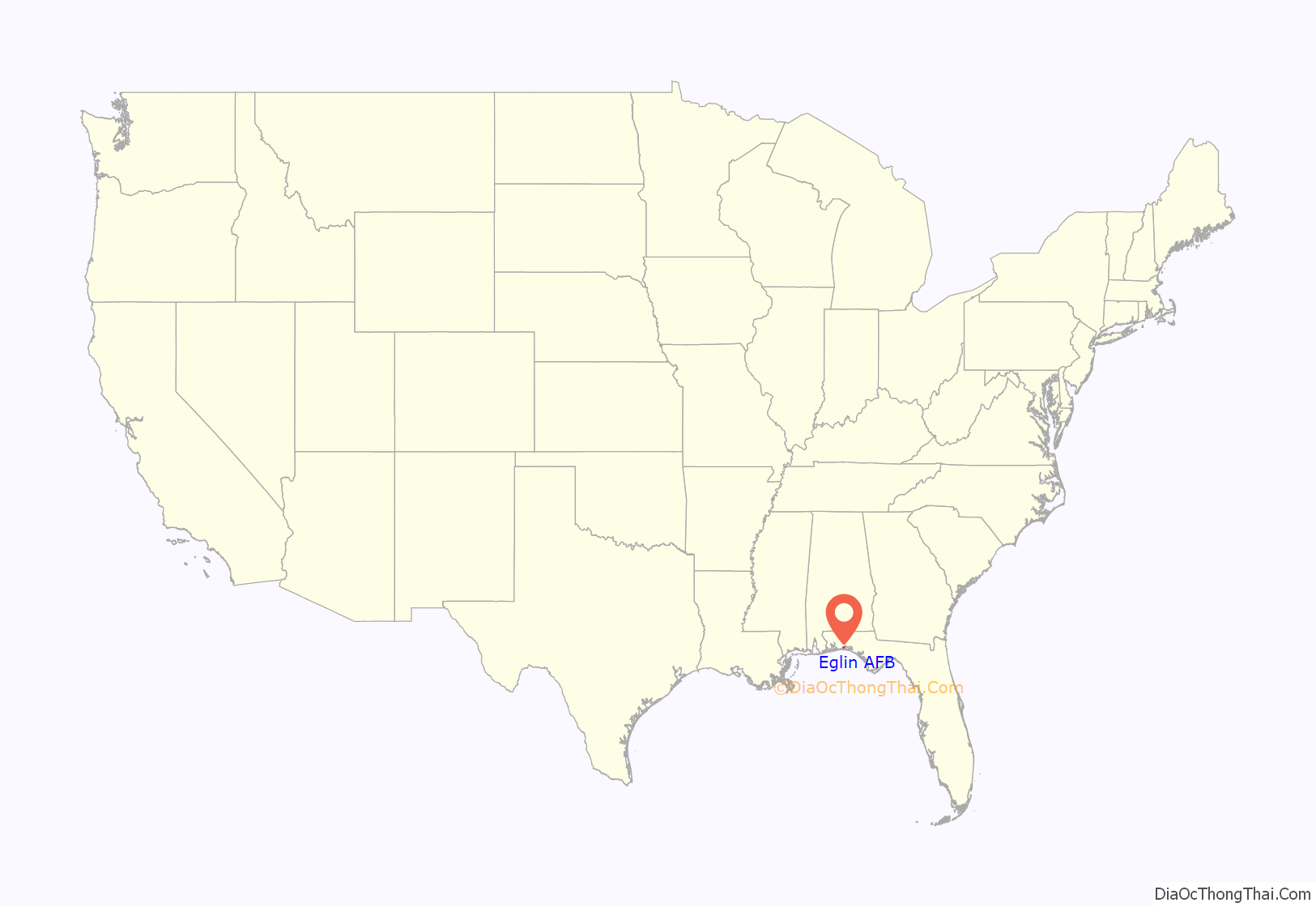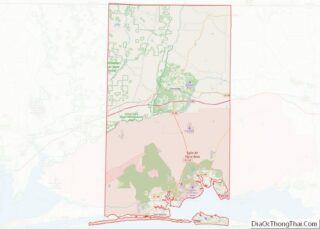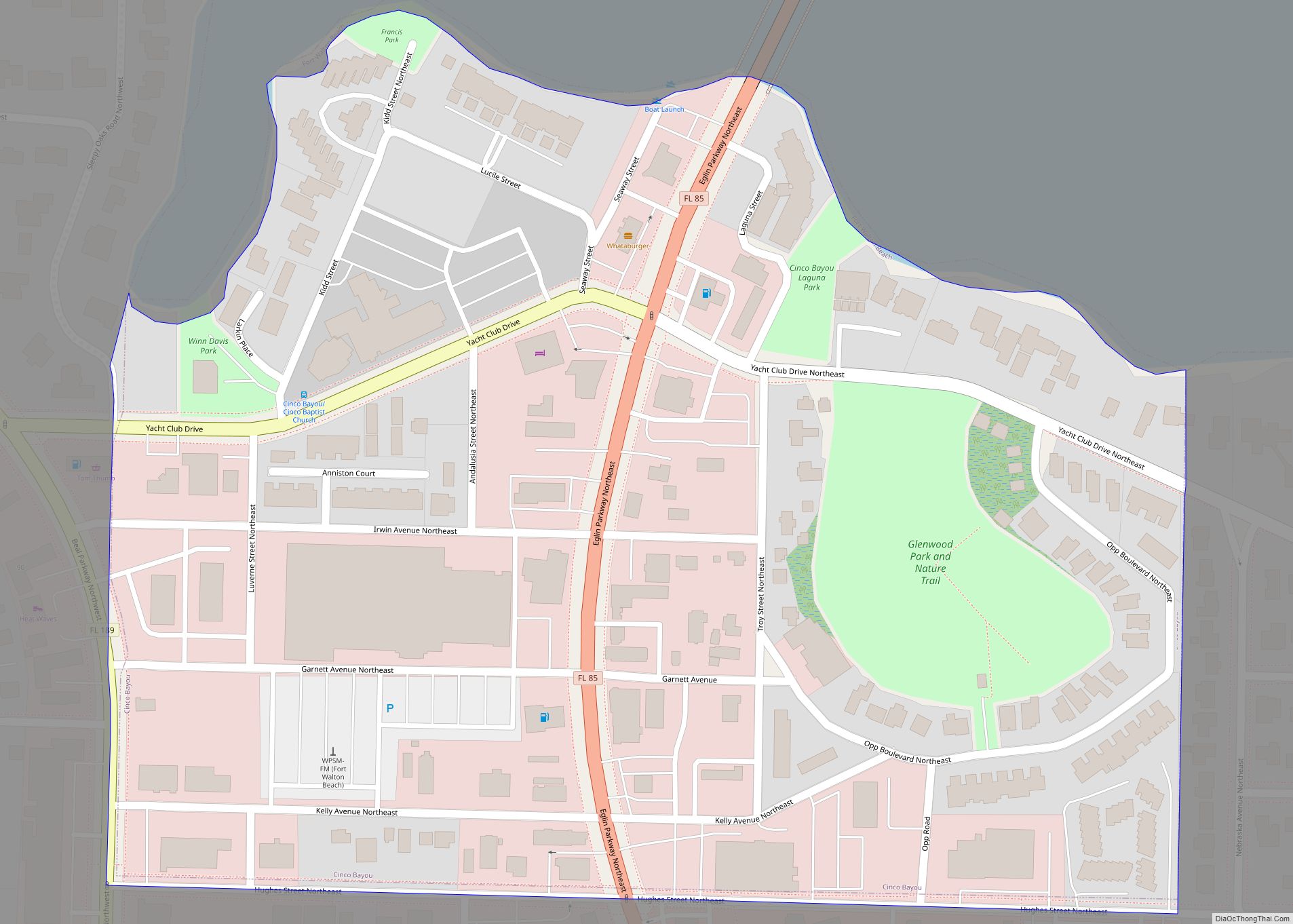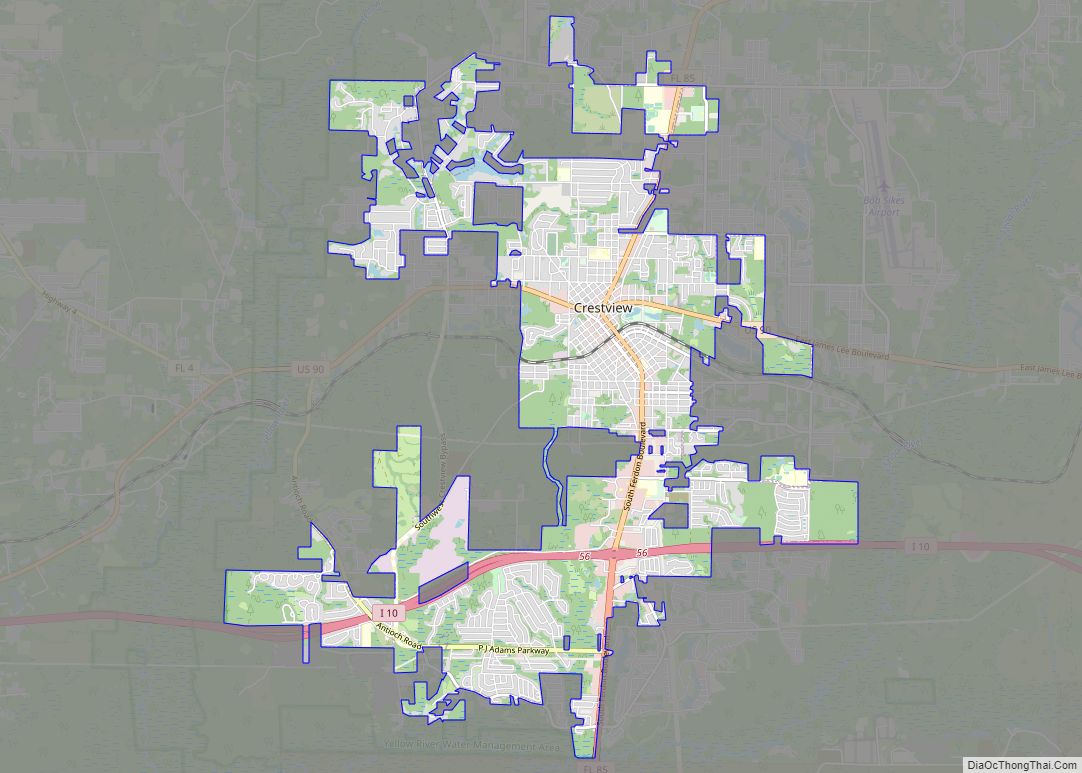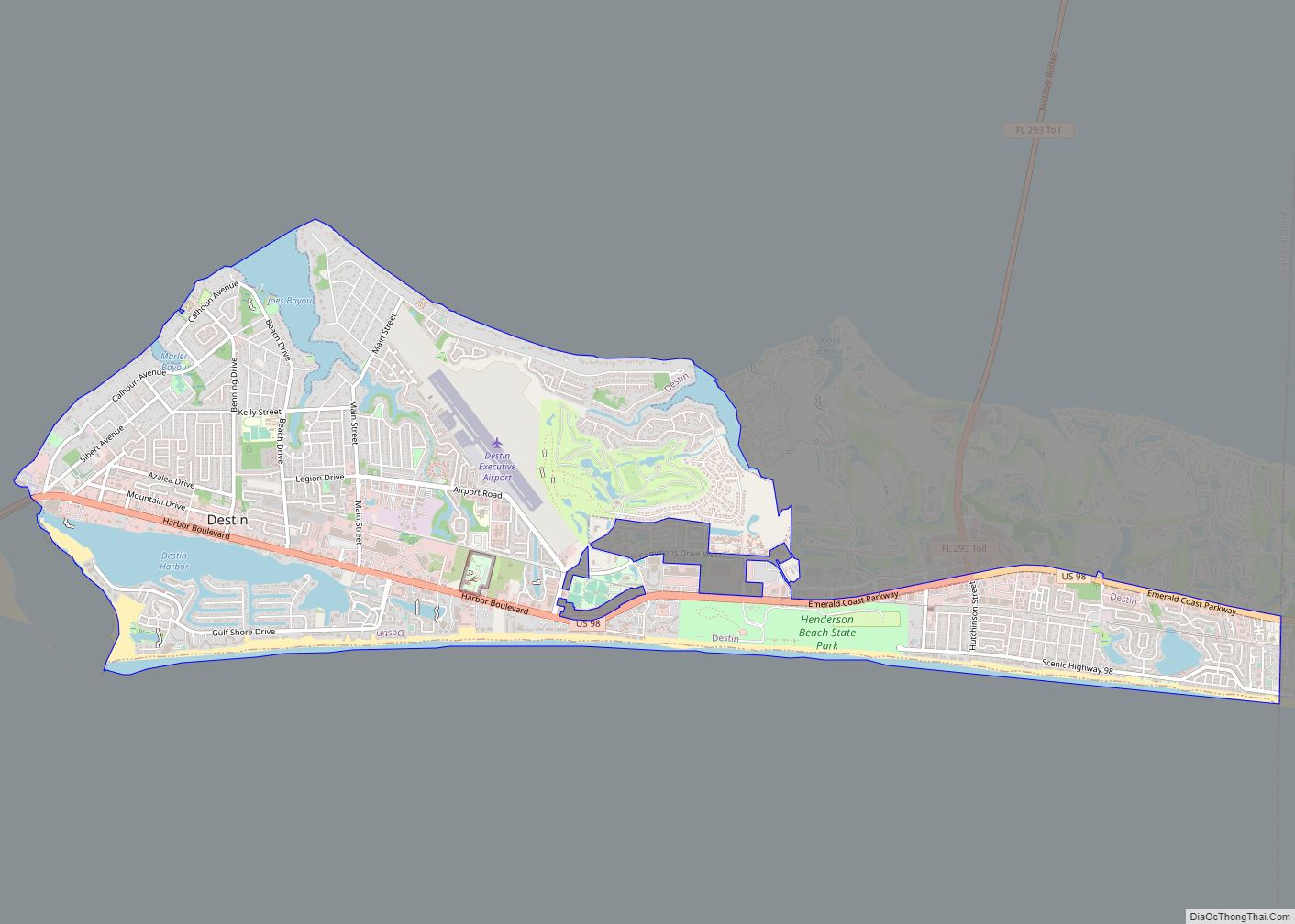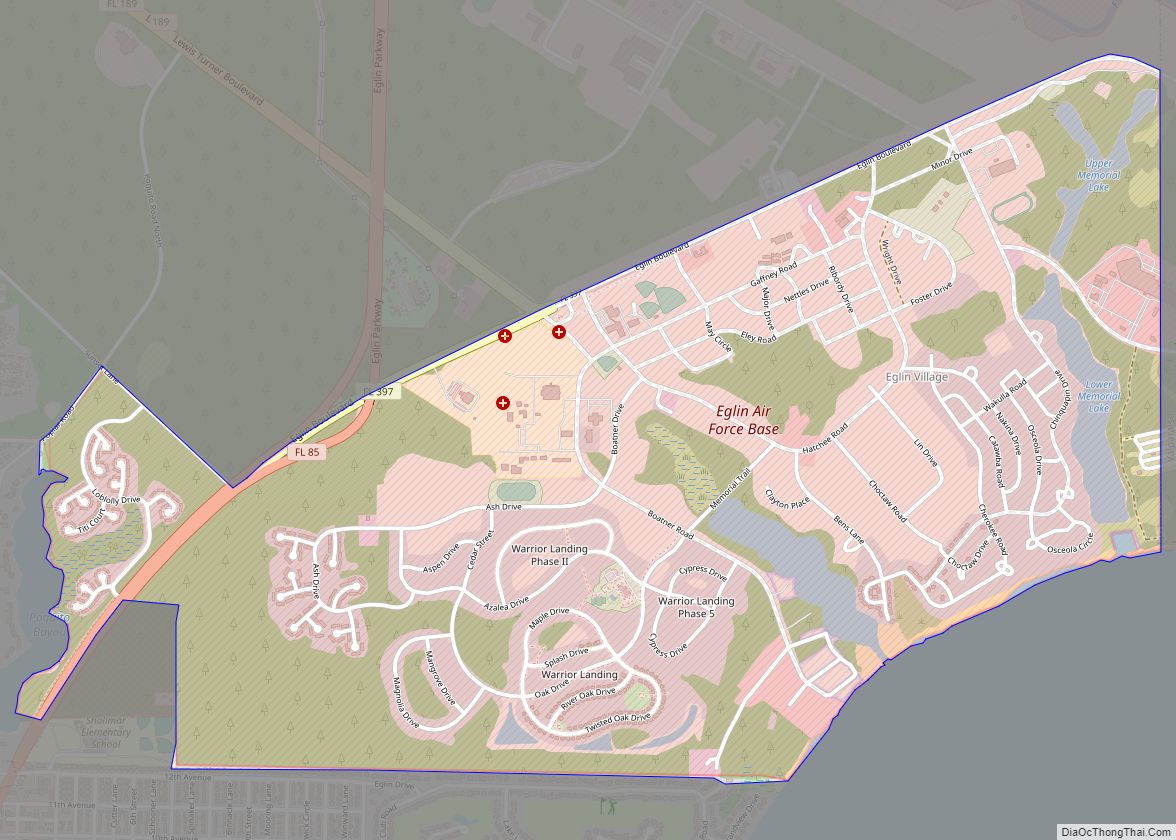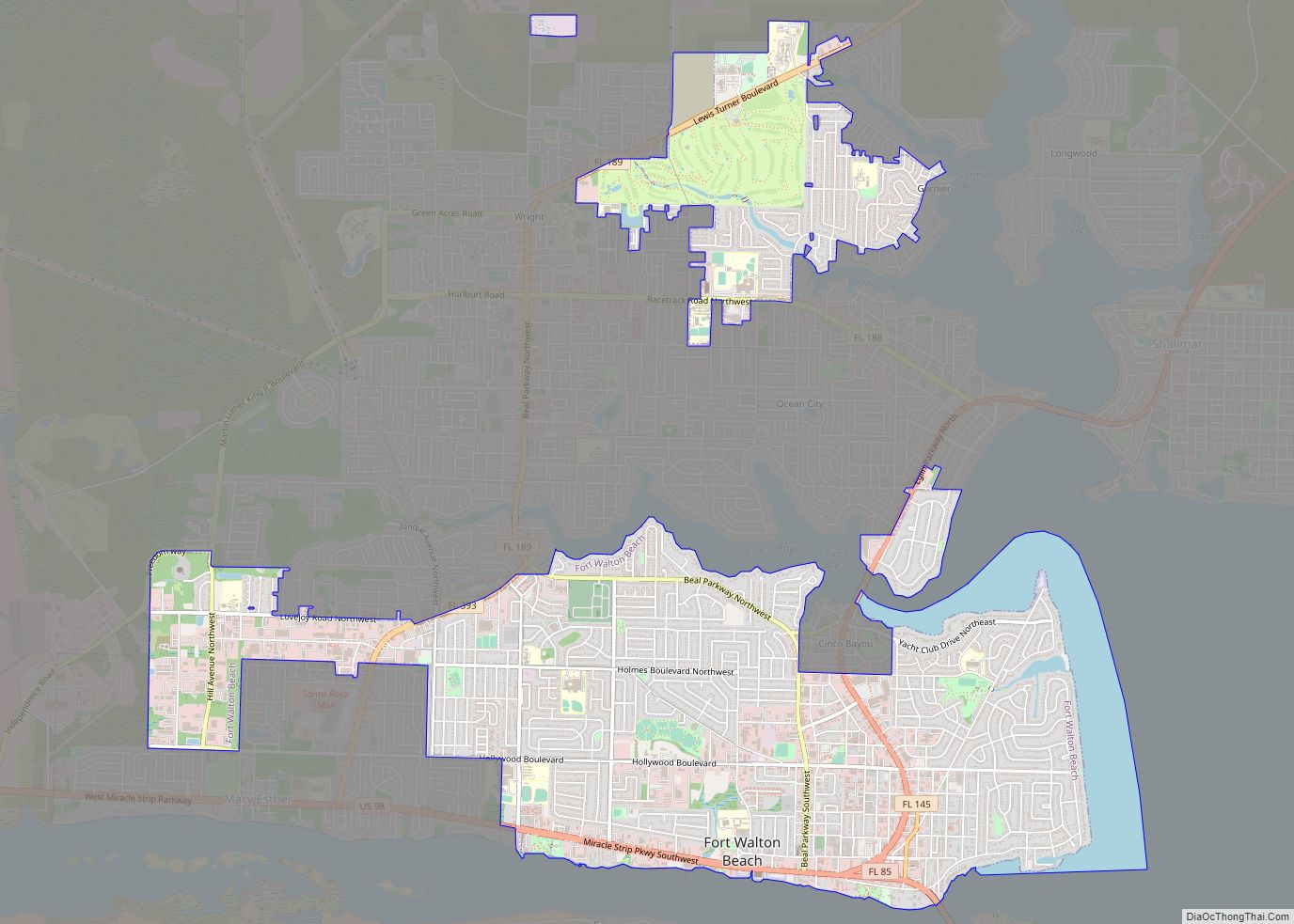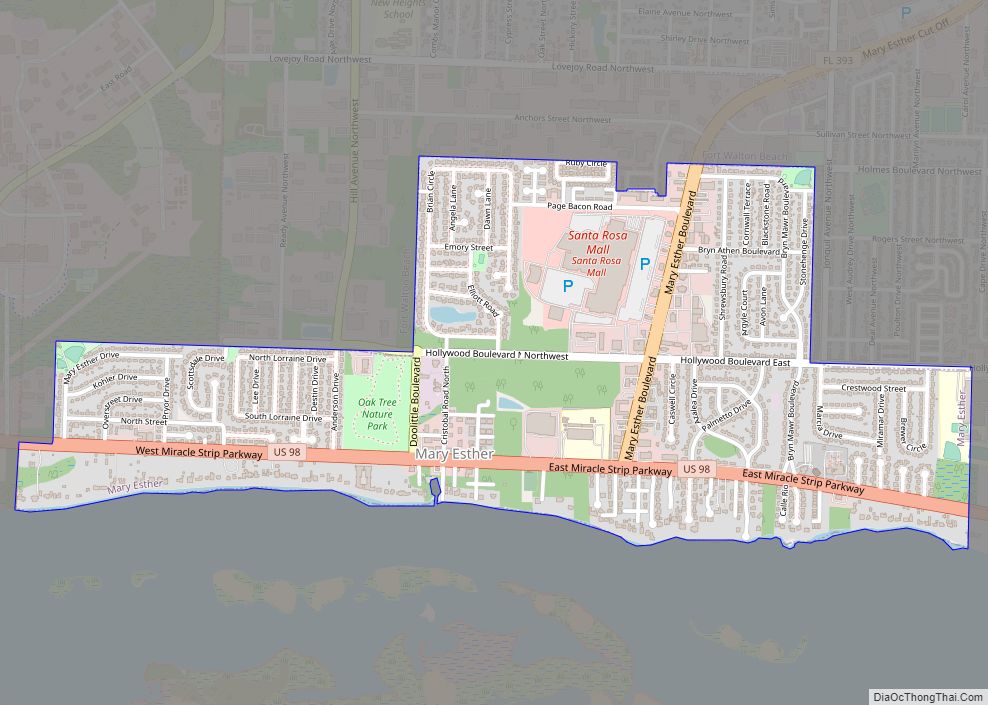Eglin Air Force Base (IATA: VPS, ICAO: KVPS, FAA LID: VPS) is a United States Air Force (USAF) base in the western Florida Panhandle, located about three miles (5 km) southwest of Valparaiso in Okaloosa County.
The host unit at Eglin is the 96th Test Wing (formerly the 96th Air Base Wing). The 96 TW is the test and evaluation center for Air Force air-delivered weapons, navigation and guidance systems, command and control systems, and Air Force Special Operations Command (AFSOC) systems.
Eglin AFB was established 88 years ago in 1935 as the Valparaiso Bombing and Gunnery Base. It is named in honor of Lt. Col. Frederick I. Eglin (1891–1937), who was killed in a crash of his Northrop A-17 attack aircraft on a flight from Langley to Maxwell Field, Alabama.
| Name: | Eglin AFB CDP |
|---|---|
| LSAD Code: | 57 |
| LSAD Description: | CDP (suffix) |
| State: | Florida |
| County: | Okaloosa County |
| Elevation: | 25.6 metres (84 ft) |
| FIPS code: | 1220050 |
| Website: | eglin.af.mil |
Online Interactive Map
Click on ![]() to view map in "full screen" mode.
to view map in "full screen" mode.
Eglin AFB location map. Where is Eglin AFB CDP?
History
Creation and World War II
Much of the base was part of a national forest until the outbreak of World War II in Europe when a proving ground for aircraft armament was established at Eglin. The U.S. Forest Service ceded over 340,000 acres of the Choctawhatchee National Forest to the War Department on 18 October 1940.
Eglin Air Force Base evolved from the 1933 creation of the Valparaiso Airport, when an arrowhead-shaped parcel of 137 acres (0.55 km) was cleared for use as an airdrome.
In 1931, personnel of the Air Corps Tactical School, newly relocated to Maxwell Field, Alabama, sought a location for a bombing and gunnery range. They saw the potential of the sparsely populated forested areas surrounding Valparaiso and the vast expanse of the adjacent Gulf of Mexico.
From October 1941 to October 1945, a USAAF Fixed Gunnery School operated at the base, supervised by the 75th Flying Training Wing.
At its peak during World War II, the base employed more than 1,000 officers, 10,000 enlisted personnel and 4,000 civilians.
Postwar
After the war, Eglin became a pioneer in developing the techniques for missile launching and handling; and the development of drone or pilotless aircraft beginning with the Republic-Ford JB-2 Loon, an American copy of the V-1. The 1st Experimental Guided Missiles Group was activated at Eglin Field, Florida, on 6 February 1946, operating out of Auxiliary Field 3. By March 1950, the 550th Guided Missiles Wing, comprising the 1st and 2nd Guided Missile Squadrons, had replaced the 1st Experimental Guided Missiles Group. The 2nd Guided Missile Squadron, SSM, had 62 pilots manning 14 B-17s, three B-29s, and four F-80 Shooting Stars, yellow-tailed drone aircraft used in the role of testing guided missiles.
In December 1955, the Air Munitions Development Laboratory was reassigned from the Wright Air Development Center at Wright-Patterson AFB, Ohio, to the Air Force Armament Center at Eglin by Headquarters Air Research and Development Command. The responsibility for development of guns, bombs, rockets, fuses, guided missile warheads and other related equipment in the armament field was transferred from the Dayton, Ohio facility at this time. Work on nuclear weapons was not included in this mission.
1960s
The USAF Special Air Warfare Center was activated 27 April 1962, with the 1st Combat Applications Group (CAG) organized as a combat systems development and test agency under the SAWC. The 1st CAG concentrated on testing and evaluation of primarily short-term projects which might improve Air Force counter-insurgency (COIN) operations. The Special Air Warfare Center, located at Hurlburt Field, undertook to develop tactical air doctrine while training crews for special air warfare in places like Southeast Asia. By mid-1963, SAW groups were in Vietnam and Panama.
The USAF Tactical Air Warfare Center was activated on 1 November 1963. It would be re-designated as the USAF Air Warfare Center on 1 October 1991.
With the increasing U.S. involvement in Southeast Asia in the 1960s, the need for increased emphasis on conventional weapons development made Eglin’s mission even more important. On 1 August 1968, the Air Proving Ground Center was redesignated the Armament Development and Test Center to centralize responsibility for research, development, test and evaluation, and initial acquisition of non-nuclear munitions for the Air Force. On 1 October 1979, the center was given division status. The Armament Division, redesignated Munitions Systems Division on 15 March 1989, placed into production the precision-guided munitions for the laser, television, and infrared guided bombs; two anti-armor weapon systems; and an improved hard target weapon, the GBU-28, used in Operation Desert Storm during the Persian Gulf War. The Division was also responsible for developing the Advanced Medium Range Air-to-Air Missile (AMRAAM), an Air Force-led joint project with the U.S. Navy.
Late Cold War era
The Air Force Armament Museum was founded on base in 1975. In 1981 the original building housing the museum was condemned and the facility closed until 1984.
Selected on 27 April 1975, the installation served as one of four main U.S. Vietnamese Refugee Processing Centers operated by the Interagency Task Force for Indochina Refugees, where base personnel housed and processed more than 10,000 Southeast Asian refugees, the first 374 of which arrived on board a Northwest Orient Boeing 747 on 4 May 1975.
In 1978, the USAF Tactical Air Warfare Center assumed responsibility for the USAF Air Ground Operations School. In the same year, the Electronic Warfare Evaluation Program became another one of the USAFTAWC’s weapons system evaluation programs, and resulted in the activation of the 4487th Electronic Warfare Aggressor Squadron in 1990.
Construction began in 1984 on the Bob Hope Village, the only retirement facility that caters to enlisted military, opening in February 1985. Residents pay below market value for the 256 independent apartments. Col. Bob Gates, Bob Hope’s USO pilot, was key in getting the comedian’s support for the undertaking, as well as lending his name to the project. He was named an honorary board member of the foundation in 1978 and held benefit concerts for nearly two decades.
Post-Cold War
During a 1992 reorganization, the Air Force disestablished Eglin’s parent major command, Air Force Systems Command (AFSC) and merged its functions with the former Air Force Logistics Command (AFLC). The newly created major command from this merger, Air Force Materiel Command (AFMC), remains Eglin’s parent command to this day. The Development Test Center, Eglin’s host unit, became part of AFMC on 30 June 1992. The 46th Test Wing replaced the 3246th Test Wing in October 1992.
On 10 August 1994 construction began on the All Conflicts’ Veterans War Memorial on the site of the old POW/MIA memorial on the western end of Eglin Boulevard. The memorial was dedicated on 15 August 1995.
As part of the military drawdown in the 1990s, the Air Force inactivated the 33d Fighter Wing’s 59th Fighter Squadron on 15 April 1999. The wing lost six aircraft and consolidated the remaining aircraft into the 58th and 60th Fighter Squadrons. Originally selected for inactivation in 1997, Air Force officials delayed the decision in recognition of the Nomads’ connection with Khobar Towers. The 59th reactivated as the 59th Test and Evaluation Squadron on 3 December 2004, at Nellis Air Force Base, Nevada. The 59th falls under the 53rd Test Management Group at Eglin.
In July 2012 the Air Armament Center (AAC) was inactivated. The center had planned, directed and conducted test and evaluation of U.S. and allied air armament, navigation and guidance systems, and command and controlled systems. It operated two Air Force installations, providing host support not only to Eglin AFB, but also Kirtland AFB, New Mexico. It had included the Armament Product Directorate (Eglin), the 46th Test Wing (Eglin), the 96th Air Base Wing (Eglin), and the 377th Air Base Wing (Kirtland).
The US Navy’s VFA-101 “Grim Reapers” deactivated on 23 May 2019 after seven years of F-35C training at Eglin.
Base railroad
Initial construction of a railroad line into the region had been discussed as early as 1927 as part of the Choctawhatchee and Northern Railroad, though military-use proposals didn’t come forward until 1941. German POWs were used in clearing and grading the alignment during World War II. There was one commercial customer served by the line, a lumber pulp yard at Niceville which is now community athletic fields. The line was later abandoned in the late 1970s and the southern end, west of State Road 285, lifted by the mid-1980s.
Eglin AFB Road Map
Eglin AFB city Satellite Map
See also
Map of Florida State and its subdivision:- Alachua
- Baker
- Bay
- Bradford
- Brevard
- Broward
- Calhoun
- Charlotte
- Citrus
- Clay
- Collier
- Columbia
- Desoto
- Dixie
- Duval
- Escambia
- Flagler
- Franklin
- Gadsden
- Gilchrist
- Glades
- Gulf
- Hamilton
- Hardee
- Hendry
- Hernando
- Highlands
- Hillsborough
- Holmes
- Indian River
- Jackson
- Jefferson
- Lafayette
- Lake
- Lee
- Leon
- Levy
- Liberty
- Madison
- Manatee
- Marion
- Martin
- Miami-Dade
- Monroe
- Nassau
- Okaloosa
- Okeechobee
- Orange
- Osceola
- Palm Beach
- Pasco
- Pinellas
- Polk
- Putnam
- Saint Johns
- Saint Lucie
- Santa Rosa
- Sarasota
- Seminole
- Sumter
- Suwannee
- Taylor
- Union
- Volusia
- Wakulla
- Walton
- Washington
- Alabama
- Alaska
- Arizona
- Arkansas
- California
- Colorado
- Connecticut
- Delaware
- District of Columbia
- Florida
- Georgia
- Hawaii
- Idaho
- Illinois
- Indiana
- Iowa
- Kansas
- Kentucky
- Louisiana
- Maine
- Maryland
- Massachusetts
- Michigan
- Minnesota
- Mississippi
- Missouri
- Montana
- Nebraska
- Nevada
- New Hampshire
- New Jersey
- New Mexico
- New York
- North Carolina
- North Dakota
- Ohio
- Oklahoma
- Oregon
- Pennsylvania
- Rhode Island
- South Carolina
- South Dakota
- Tennessee
- Texas
- Utah
- Vermont
- Virginia
- Washington
- West Virginia
- Wisconsin
- Wyoming
